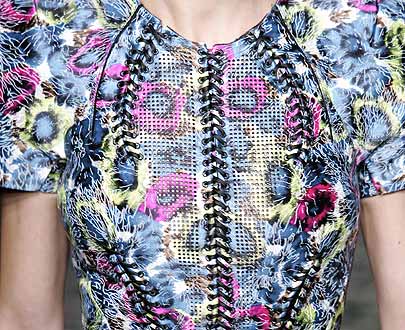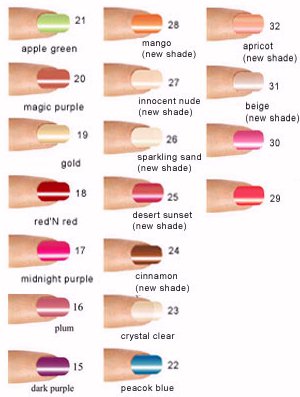| Wild Prints & Green Nail Polish
The Fashion eZine - Decorative
Wild PrintsBy Derick Chetty. PARIS – When an conceptualist designer like Hussein Chalayan – renowned for having once featured a wooden coffee table as a skirt and dresses illuminated with LED lights – shows a collection that includes plain handkerchief hem tunics, ordinary shorts suits and uncomplicated accordion-pleated dresses, as he did on Wednesday night, it neatly sums up the mood designers in Paris are projecting for next spring/summer. Their modus operandi seems to be designing wearable clothes that will actually sell. Even the format of the Chalayan show – eschewing a runway altogether – was a simple video presentation in an art gallery showing a few models against a black background moving in and out of the camera lens for all of 10 minutes. With Paris fashion week drawing to a close on Sunday and some of the big French fashion houses like Lanvin, Chanel and Louis Vuitton yet to show, the runways so far have featured a lineup of commercial clothes for real women – at least those with the high-rolling bank accounts. It seems the City of Light has turned down the wattage this season and London, which seems to be having a fashion renaissance, is the capital that's churning out new ideas. British wunder-boys Christopher Kane and Giles Deacon seem to be the bright beacons on the horizon. But why the reality check here in Paris, the fashion capital the world looks to for flights of fancy when it comes to frocks? It could be argued that with some of these houses turning out six or more collections a year, if you count menswear and resort, there has never been more pressure on a designer to come up with ideas. Even for the most talented, not every collection can be a mega-hit. Or it could be that the men who control the purse strings are sending out their own memo to the design department: make clothes that will sell. Yes, fragrances and accessories are the cash cows, but why shouldn't the clothing be utilized to increase those profit margins? Emerging markets like Russia, China and India have a voracious appetite for luxury labels but these newcomers to the fashion scene are looking for clothes, not with edge, but that they can wear with assurance that their outfits spell out status and wealth. And perhaps that is why this week's collections, while safe and commercial, have also been in quintessentially classic Parisian good taste. Even the ring leader of theatrics, John Galliano, toned it right down for Dior with pinstriped suits, bias cut dresses and flapper cocktail numbers. If there was one big fashion trend that emerged it was a riot of prints and a bonanza of botanicals. Dries Van Noten sent out a kaleidoscopic collection that deftly mixed several unrelated colourful graphic florals. Some fabrics mixed two or more clashing prints. But he made it look so easy, charming and feminine, that these were dresses, tops and soft pyjama-style pants that women will want to cherish forever. Bright and romantic, they will certainly hold a special place in a wardrobe. Christian Lacroix, another mix master of prints, sent out an exuberant collection that featured broad, abstract, painterly brushstrokes. But among the powerful prints and wild headwraps on models, were pencil slim skirt suits that resonated French chic. One designer exiting his long and storied career on a high note was Valentino, who showed his last ready-to-wear collection this week. His label will continue under Alessandra Facchinetti, the designer most known for succeeding Tom Ford at Gucci until she was let go after a few seasons. The show was not a melancholy affair but rather boasted a foot-tapping soundtrack of disco hits and a lineup of what he did best for the past 45 years came sashaying down the runway. Elegant column dresses, ruffles and bows, swirls of feminine polka dots and svelte skirt suits. Here was a designer who built a stellar career and remained relevant and successful for more than four decades by giving women what they want; feminine, sexy, glamourous and utterly wearable clothing.
Nail polish goes GreenSee Also Sustainable Fashion By Erin Kobayashi. My favourite nail polish is green. Well, the actual colour is a milky pink lacquer, Number 12 by Suncoat Products Inc. What makes it green is the fact that it is water-based, unlike conventional nail polishes, which have a solvent base. "We are replacing the chemicals in conventional nail polish with water," explains Guelph-based chemist and Suncoat founder Yingchun Liu. "It means that in our bottle, roughly 70 per cent of the nail polish is water, whereas in traditional nail polish, 60 to 70 per cent is chemicals." Those chemicals include acetates that release fumes, have a strong odour and are highly flammable. As well, Suncoat Nail Polish is free of acetone, alcohol, formaldehyde, phthalate and toluene. Liu's quest to find a more environmentally friendly and less toxic nail polish began in 2001. "My 7-year-old daughter, Mimi, wanted to wear nail polish," remembers Liu, a mother of two girls. "I couldn't let her wear the regular nail polish because it was so toxic, so I made my own." For a year, Liu worked from her garage in Guelph, refining the recipe for her water-based polish. She wasn't starting from scratch, though. "I have a master's degree in organic chemistry from the University of Calgary," says Liu, who came to Canada in 1988 from Nanjing, China, on a scholarship. "I've worked for years in the chemical industry with environmentally friendly coatings and paints." Thirty-three colours and two awards at the Canadian Natural Products Expo later, Liu's recipe for a more natural nail polish seems to have worked. I could immediately smell the difference; Suncoat had a faint odour reminiscent of cheap chocolates, while conventional polish smelled poisonous in comparison and left me gagging. Suncoat performed about as well as conventional drugstore and designer polishes, drying quickly and lasting just as long before it began to chip. Perhaps that is because the remaining 30 per cent of the polish consists of plastics that coat the nail to make the polish stay in place. Suncoat Natural Nail Polish Remover, a corn- and soy-based liquid, can remove both Suncoat and conventional polishes. I'd highly recommend this biodegradable and petroleum-free vegan product, along with the polish, to aestheticians who deal with nails daily. Visit suncoatproducts.com to find a retailer or order online.
|
|

